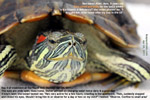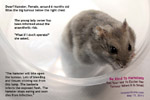The Silkie Terrier went home on Sunday, August 7, 2011. Twenty-one days after his perineal hernia repair. This is the high-risk and difficult surgery that I prefer not to encounter. The satisfaction is that the old dog would have had died had this surgery not been performed. There are many post-operation complications when such perineal hernias have had been delayed for many months.
1, Loose stools indicated a colitis due to the rectum area being dilated with stools accumulated there for so long.
2. The bladder was herniated but the dog behaved "normally". He could manage to strain to pee and urine-mark. Superficially, he appeared normal but I noted that he just could not pee at one go at any time. He could eat, drink, pee and poop loose stools. He was alert and active but changes in his perineal hernia foretold imminent death from rupture of the skin.
3. Large intestines were inflamed but fortunately not strangulated of blood supply.
4. The skin of the perineum where the bladder and intestines were pressing over the months was paper-thin and white, indicating that the blood vessels were almost non-existent. So, the skin cells died after surgery and would have had ruptured and died even if no surgery was done and the guts would have spilled out causing a painful death for the dog. Gangrene set in and the white thin skin started dying. An immediate surgery is not advised till the skin stablised. This took a few days of treatment, cleaning and worries.
5. Two general anaesthesias were needed to repair the hernias and to debride and stitch up the gangrenous skin. The perineal hernia repair took 2.5 hours while the stitching took over an hour too. Surprisingly the dog survived.
6. Neutering was postponed as I did not want to risk the 3rd general anaesthesia. What if the old dog's heart fail and how would the owners feel if the dog died on the operating table? I don't take chances. A live dog is what the owners want although they did expect the worst. A dog without two big backside swellings post-operation too. The expectations were high. Yet this dog continued to stand on his hind legs, to paw his front legs together to greet me as if to ask me to let him out to play and urine-mark again and again.
7. In conclusion, the clinical outcome 21 days after the repair is good. But will there be a recurrence? Will the dog die on the operating table during neuter to be scheduled in 2 weeks' time. I don't know. What if the dog is not neutered? He will continue to urine mark obsessively. The perineal hernias may recur.
Even if he is neutered, he will not stop his behaviour. But urine-marking will be reduced in frequency. Much depends on the owners' restraint of the dog from walking on hind legs, from urine-marking onto cockroaches, from urine-marking at any place. It is easier said than done when the dog is in his senior years!
VETERINARY
COSTS
It costs a lot of money to repair complicated perineal hernias due to a
lot of professional time and care required. Early
perineal hernias are easier to repair and costs much
less. In this case, I capped the costs of the two long
anaesthesias and operations and post-operation care
for 21 days at $2,500. It is just not possible to
reduce costs to a level that professionalism and
ethics are compromised and the clinical outcome
becomes unsatisfactory.
CONCLUSION
Neutering the male dog at a young age will have
decreased the chance of perineal hernias developing as
neutered dogs rarely get this condition. Why? My
hypothesis is that they don't have this obsession to
urine-mark on any surface. This habit would have
strained the weakened pelvic diaphragm which separates
the pelvic cavity (where the bladder and intestines
are located) from the perineal region (where the anus
is located). Too much urine-marking leads to perineal
hernias in old age. That is my hypothesis which seem
to be borne out as this old rascal does catch and
urine-mark on cockroaches too! Maybe the rubbish chute
should be cockroach-proofed?
THE FOLLOWING IS THE RESEARCH REPORT TO BRING VETERINARY SURGERY ALIVE FOR THE VETERINARY UNDERGRADUATES STUDYING PERINEAL HERNIAS. IT TAKES MUCH MUCH LONGER TO PEN THIS REPORT THAN TO OPERATE! I HOPE THE YOUNG ONES - THE GOOGLE GENERATION - ENJOY READING THIS CASE REPORT.
| DAY 1 OF PERINEAL HERNIA REPAIR | |||
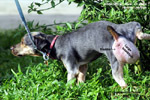 |
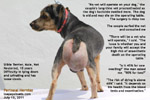 |
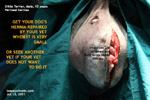 |
 |
| DAY 3 AFTER PERINEAL HERNIA REPAIR - GANGRENE STARTS IN THE THINNED SKIN | |||
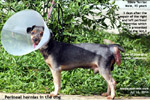 |
 |
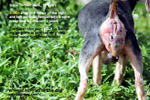 |
Perineal hernias in a Silkie Terrier repair pictures. Update on a Boston Terrier's perineal hernia |
| DAY 7-10 AFTER PERINEAL HERNIA REPAIR - GANGRENE ENDS. 3 BIG SKIN HOLES | |||
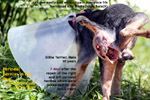 |
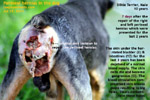 |
||
| DAY 11 AFTER PERINEAL HERNIA REPAIR - DAY 1 OF STITCHING UP THE SKIN | |||
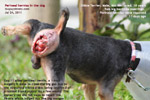 |
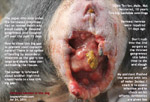 |
 |
 |
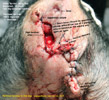 |
 |
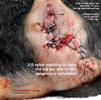 |
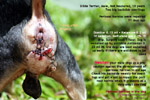 |
 |
 |
||
|
DAY 13
AFTER PERINEAL HERNIA REPAIR
- DAY 3 AFTER STITCHING |
DAY 18 AFTER PERINEAL HERNIA REPAIR - DAY 6 AFTER STITCHING | ||
 |
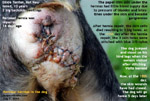 |
||
| DAY 21 AFTER PERINEAL HERNIA REPAIR - DAY 14 AFTER STITCHING. GOES HOME | |||
 |
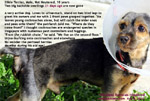 |
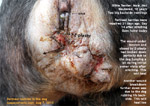 |
|
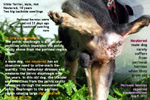 |
|||
 TOA
PAYOH VETS
TOA
PAYOH VETS

